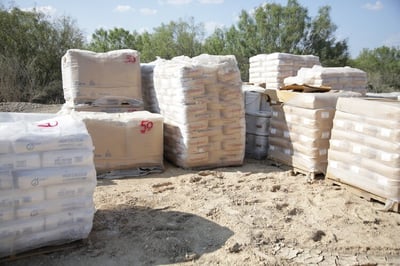 To maintain mud properties during drilling, various additives and chemicals are typically added over the course of the drilling program. Here we provide a definition and description of some of the most common additives.
To maintain mud properties during drilling, various additives and chemicals are typically added over the course of the drilling program. Here we provide a definition and description of some of the most common additives.
(Note: This typically does not apply to air and foam fluids as the additives are either in liquid or solid form and do not mix with air and foam.)
Weighting Agents such as Barite. Barite is one of the main weighting materials and is used to increase the density of the mud to equalize pressure between the wellbore and formation when drilling through pressurized zones. However, the density of the mud impacts the solids control system and affects the speed and number of centrifuges needed to remove ultra-fine cuttings. Screens may need to be adjusted for optimum solids removal. Other weighting agents include siderite, calcium carbonate, hematite, ilmenite and galena.
Dilution is the process of adding base fluid to the drilling mud to decrease solids concentration. This is important when new hole is drilled, and mud properties must be maintained as mud volume increases. Dilution volume is added to the mud to control solids and to maintain volume. Maintaining a stable hole environment sustains hole integrity, controls reactive shale and maintains a consistent mud system when encountering contaminants.
Shale Inhibitor When drilling in clay, water that comes into contact with the clay can cause the clay to expand and swell. When this happens, the BHA and drill string can be squeezed, causing sticking in the hole. Like the name implies, shale inhibitors inhibit reactive shales when they encounter water and minimize waters ability to hydrate the shale, helping stabilize the formation.
Fluid Loss Control Additives help control fluid loss into the formation and protect reactive shale formations during drilling. This is achieved by a providing a protective seal along the borehole wall, strengthening the wellbore. Fluid loss control additives make the fluid more stable and less likely to penetrate the formation, reducing the amount of interaction with the shale.
Thinners or Dispersants reduce gel strength and help control rheology of the mud. These additives thin the mud by separating particles so they can be carried out of the hole by the drilling fluid. Lignite, desco, and lignosulfonate are common types of dispersants.
Lost Circulation Material Drilling fluid loss occurs when the drill string encounters fractures and highly permeable zones. When this occurs, these areas must be quickly sealed to stop the loss of expensive drilling mud into the formation. One of the common methods is to pretreat with lost circulation material into the drilling fluid. Common lost circulation material includes calcium carbonates, crushed mica, cellulosic plant particles and graphite. Traditional organic materials such as peanut or walnut shells, and in extreme instances coconut hulls and palm leaves, have also been used.
Corrosion Inhibitors protect the pipe, drill bit and other metallic components from acidic compounds encountered in the formation. Common types of compounds that can cause corrosion include carbon dioxide, oxygen, and hydrogen sulfide. Some common corrosion inhibitors include iron oxide, aluminum bisulfate, zinc carbonate, and zinc chromate.
Surfactants decrease the surface tension between two different substances and is used as an additive to water-based drilling fluid to change the colloidal state of clay from complete dispersion to controlled flocculation.
Biocides are chemical additives that control microbial growth such as sulfate-reducing bacteria, slime-forming bacteria and iron-oxidizing bacteria. They are commonly used in water-based muds containing natural additives such as starches and gums that are susceptible to bacterial attack. Common biocides include organic amines, chlorophenols and formaldehyde.
pH Control Agents The pH value represents the alkalinity of fluid and ranges from zero to 14, with a pH of seven considered neutral. Fluids above seven are considered alkaline and fluids below seven are considered acidic. When mixed with water, many drilling fluid additives are designed to function within a pH range of 8.5 to 10. This allows the additives to become soluble and disperse and in effect, function. The pH can be adjusted to the proper level by adding specific additives to the water. Two of these additives include caustic soda and potassium hydroxide.
At Panther Fluids Management we help determine the best additives to maintain the mud system on your well in addition to the right solids control system, equipment and personnel. Our drilling fluid systems are backed by years of experience and have consistently lowered overall mud costs for clients. We consult with the operator to design the best fluid system for each well; including everything from discrete services like mud and screens to fluids engineering to complex closed-loop systems for solids control to haul-off and disposal. We understand the total fluids life cycle and can prepare for many contingencies based on well conditions. Contact Panther Fluids Management today for the latest in drilling fluids technology.

